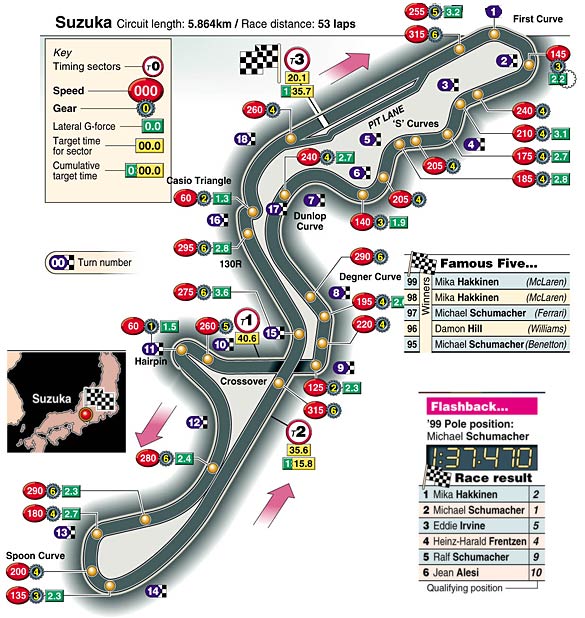| ATLAS F1 Volume 6, Issue 40 | |||
 |
A Lap of Suzuka | ||
|
Fastest Race Lap: 1:38.942 (H.H.Frentzen, Williams, 1997); Fastest Qualifying Lap: 1:34.700 (G.Berger, McLaren, 1991)
The Suzuka Circuit in Japan currently stands out as a high point in a world populated by bland and dreary Grand Prix tracks. Designed by the man responsible for the challenging Zandvoort circuit, Suzuka is unusual in that it crosses over itself in a figure-of-eight.
The track is twisty, but fast, and some sixty percent of the lap is spent at full throttle - more than Hockenheim. Expect to see the cars running medium levels of downforce as the teams cope with the need for high cornering speeds and extra speed on the straights.
High points of the lap are the many long and tightening corners: First Curve; Degner and Spoon. With the correct racing line being particularly critical around these, expect the time spent racing in Formula Nippon to be of particular value to Heinz-Harald Frentzen, Eddie Irvine and Mika Salo.
The only sore point on the circuit is the ridiculously tight Casio Chicane, as well as the lack of sufficient run-off at some of the faster corners. All said and done, though, Suzuka is one of the few remaining challenges in Formula One and well deserves its place on the calendar.
"Suzuka is one of the finest tracks we go to, and I rate it very highly. It's even more critical than Spa in terms of matching the set-up with your speed and commitment.
"Depending on the wind, the pit straight is probably the fastest point. You maybe hit 320km/h going into the first corner. You're in fifth gear, it's very fast, there's not a lot of steering - you just brake as late as you can. You don't have to put much power on between Turn 1 and Turn 2 - you take the first as fast as you can, and sort yourself out afterwards. It's third gear for Turn 2, with a late apex to have maximum traction.
"Turns 3, 4 and 5, the Esses, are pretty much on a flow. You cannot use the brakes very hard, because you upset the ride height. It's a bit bumpy, so you have to have the aerodynamics working quite well there. Turn 6 is a bit tricky, because you have a bit more understeer than you normally have on 3/4/5, because it's a much tighter corner.
"So either you put on much more lock and keep it tight, which is slower in the middle of the corner but faster out, or you don't tend to turn much, be very wide on the exit of Turn 6, and then you're going to have a little bit of a problem with Turn 7. But sometimes that is the quickest way.
"Seven is very bumpy. It's a long, long corner, you're in fourth gear on the way in, and fifth on the way out. It's a good fun corner, and in the wet it's pretty slippery. For Turn 8 you brake down to fourth again. If you ride the kerbs, the car has to be very soft, otherwise it jumps out. And if you go straight on at Turn 8 it's very difficult to rejoin the track again for Turn 9.
"Braking into Turn 9, there's always a bit of oversteer, and there's a little bit of a camber in the middle of the corner. If you get to the middle of the corner fast, the camber helps you out. It's fascinating to go under the bridge, because you're not used to having someone crossing on top of you! It's often damp underneath there.
"At Turn 10 the most amazing thing is you can brake and spin to the inside - it's easier than spinning to the outside! A couple of years ago Damon went off there. You have to brake very late for the hairpin, put a lot of commitment into the corner, and it's so easy to lock the wheels and lose yourself there. It's a corner where you can make a lot of good time. There's a lot of traction out of it.
"Turn 12 is a long corner - in the wet it becomes a corner, in the dry it's not really - it's just flat all the way through, very bumpy, especially when you get to Turn 13, Spoon Corner. I feel that it's the most fun on the track. You brake down to fourth, put full throttle back again, then brake again to third. You have to concentrate because you have to be very, very early on the throttle, because you have the long straight after that. Again, if you go off on the first part it's sometimes difficult to come back.
"Then we head into 130R, which is one of the fastest corners in the world. We probably don't have enough run-off area! If your car isn't very good, it's not much fun. You just have to make it as fast as you can on the way in; you're talking about 305km/h (190mph) and getting out of the corner at 285-290km/h (177-180mph). Then you brake for the chicane. You can lose everything if you brake too late at this last corner, which makes it exciting, because you have to be really precise.
"The braking area is blind, and you try to make it into a straight line as you turn in, and hit the kerbs as much as possible because the car understeers. Then you're dealing with a lack of traction. The track falls away, and all the time you're spinning your wheels. You have to be polite with the throttle..."
The official Japanese GP web site
The 1999 Atlas F1 Japanese GP Review Issue
|
| Atlas F1 | © 2000 Kaizar.Com, Incorporated. |
| Send comments to: comments@atlasf1.com | Terms & Conditions |
